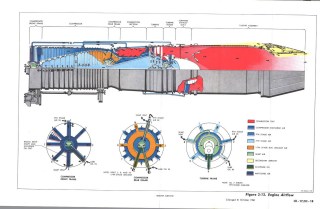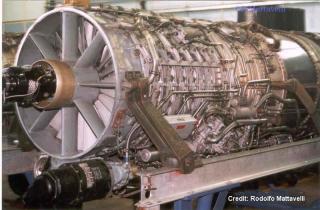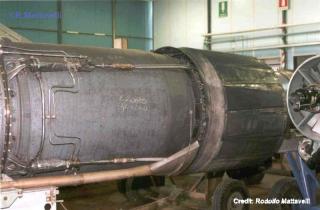General Electric J79
Engine Overview
Until the creation of the Mach 2 J79, most engines had been designed essentially independently of the aircraft they eventually powered. The J79 was the first GE engine designed with the sophistication provided by already developed and demonstrated components and advanced instrumentation techniques for projecting test performance.The J79's first flight took place in Schenectady, New York in 1955. The J79 was placed in a bomb bay of a J47-powered B-45 Tornado. The engine was tested by lowering it from the bomb bay into the air stream. The four J47s were shut down and the J79 powered the B-45.
The J79 was first flown aboard the XF4D and later set a world altitude record at 91,249 feet and a speed record of more than 1,400 miles per hour in a F-104 Starfighter.
The J79 was later selected to power the F-4 Phantom. At the time of its introduction, the J79 was the most advanced turbojet ever designed. To date, more than 2,500 engines are still in service and are projected to continue through 2020.
Found on these aircraft:
B-58F-4
F-104
Kfir
A3J Vigilante (RA-5)
F-16/79
Introduction: 1954
Thrust Range: 17,820 - 18,730 lbs.
Models
J79-GE-2: 15,000 lb (66.7 kN) afterburning thrust
J79-GE-5A: 15,600 lb (69.4 kN) afterburning thrust
J79-GE-7A: 15,800 lb (70.3 kN) afterburning thrust
J79-GE-10: 17,860 lb (79.4 kN) afterburning thrust
J79-GE-15: 17,000 lb (75.6 kN) afterburning thrust
J79-GE-17: 17,900 lb (79.6 kN) afterburning thrust
J79-GE-119: prototype engine for export version of F-16A
Specifications
Turbojet
Compressor: 17-stage axial with variable stators
Turbine: 3-stage
Mass flow: 170 lbs/sec
Power ratio: 13
The J-79 is a monster of a engine. It is just over 17ft long, and slightly more than 3 ft in diameter,
and weighs around 3,600 lb. It is a single-shaft engine whose later high-pressure compressor stages incorporated variable-incidence stator blades.
These movable components are linked together mechanically so that their position can be controlled by the fuel supply.
The compressor has 17 stages and is driven by a three-stage turbine.
The engine for the NAE is supplied by S & S Turbines of Port St. John, BC.
So successful has been the design, that it has been used in the F-104 Starfighter, the B-58 Hustler,
the F-4 Phantom and the A-5 military planes. In fact the design of the J-79 is not new.
It is a proven powerplant. On February 17th of this year (2001), the J-79 celebrated its 45th birthday!
On that date in 1956 the first powerplant flew in a F-104A fighter jet. Forty years later, like many of
the North American Eagle project team, it is still running strong!
General Electric Company's Flight propulsion Division, designer and
manufacturer of the Super Starfighter's J-79 jet engine, is America's
pioneer in the field.
In 1941 General Electric produced the nation's
first turbojet powerplant - designated the I-A.
It weighed 780 pounds and had a thrust - or pushing power - measured
at 1300 pounds. Pursuing its pioneering advantage, General Electric during
World War II developed a new style engine built around an axial flow
compressor.
Earlier models, such as the J-33 which powered Lockheed's
F-80 Shooting Star, used a centrifugal compressor that propelled air
outward from the center of rotation.
Axial flow means that the air
flows straight through, "packed" ever tighter by a series of spinning
fan-like blades before fuel is added and ignited.
The one big goal of
engine manufacturers was an engine combining light weight with high
thrust, mechanical simplicity and reasonable fuel economy.
With the
J-79, that goal was reached.
 |
 |
 |
The engine's thrust-to-weight ratio - 3500 pounds weight and 15,000 plus pounds thrust - is unprecedented.
Developed in co-operation with the U.S. Air Force under the government's weapon system management concept,
the J-79 was the first production engine capable of powering aircraft twice the speed of sound.
It had more than 12,000 hours of factory, simulated altitude and flight testing time before reaching the production stage. Variable-pitch stator blades adjust automatically to (1) reduce stall problems at low engine speeds,
(2) give maximum compressor efficiency under all flight conditions and (3) to match engine and airframe induction system for good stall margin at high airplane speeds.
The design permits rapid acceleration from idle to full power
without compressor stall - a feature labeled by military pilots as
"amazing".
The J-79 is 207 inches long, with a 36-inch frame size.
Pressure ratio is 12:1. Engines installed in the F-104G,
F-104J and
F-104DJ - assigned a designation of J-79-11A - weigh approximately 3500
pounds, and are rated at 10,000
pounds thrust without or 15,000 plus
pounds thrust with afterburning.
The compressor
The axial flow compressor has 17 stages and a
single rotor, with the first six stator stages and inlet guide vanes
variable.
Rotors are made of thin webbed discs and spacer rings bolted
together.
Blades are attached to the rim sections by conventional
dovetails.
(Top and bottom compressor casing sections can be removed
for inspection and maintenance.)
The combustion chamber
The annular-design combustion chamber has
a split casing that can be disassembled quickly and contains 10 combustion
chambers.
Anti-icing
Compressor discharge air guards against inlet guide
vanes and struts icing.
The turbine
Wheels of the three-stage turbine are coupled to the
compressor rotor by a conical shaft for low weight and high strength.
The light weight casing is made of fabricated sheet metal. Top and
bottom sections are removable.
Controls
The engine's separate fuel systems - main and
afterburner - both are flow controlling units, hydro-mechanically
operated.
An integral part of the basic engine, controls have
electrical trim, with both hydraulic and electric power.
Overall, the
system serves main fuel, afterburner fuel, nozzle area and variable stator
controls (integrated with main fuel controls).
Afterburner features:
fully modulated, variable area, with a converging diverging exhaust nozzle
that works automatically.
From GlobalSecurity.org
General Electric's answer to Pratt & Whitney's JT3 (J57) was the J79, with an innovative compressor with variable stators. General Electric’s approach was to design a single spool 17 stage axial flow compressor with variable stators to prevent rotor blades from stalling. These controllable stators, or the variable geometry compressor as it came to be known, were the foundation for the J79 series of military engines. Pratt & Whitney used a successful high pressure ratio (12:1) design consisting of two separate compressors in series (one with nine stages and one with seven stages). The two compressors ran at different rotational speeds and were only aerodynamically coupled.The development of the J79 turbojet began in 1952 as a more powerful follow-up to the General Electric J47 turbojet. The General Electric J79 engine was a high-performance single-shaft turbojet that featured variable-incidence stator blades in the later high-pressure stages of its seventeen-stage compressor. The J79 turbojet, the first high-compression variable-stator engine built in United States by GE, powered most Mach 2 U.S. aircraft, including the F-104, B-58, F11F-1F, F4H, and A3J, as well as the Regulus II missile. The production F-104 was capable of flying at Mach 1.8, while the twin-engined F-4 Phantom and the four-engined B-58 were both capable of flying at over twice the speed of sound. The engine has seen decades of faithful service and has stood the test of time.
Widely used on several types of aircraft, including the Israeli Aircraft Industries Kfir, more than 17,000 examples of the J79 were built in its thirty-year production run. In its long and successful career the dependable J79 accumulated well over 30 million flying hours and probably clocked more supersonic flying time than any other Western military aircraft engine produced during the Cold War. Civilian variants of the J79 also powered the Convair 880 and 990 airliners.
The J79 was developed as an outgrowth of the General Electric J73 engine program and was known at first as the J73-GE-X24A. The X24A was designed for reliable Mach 2 performance with minimal required maintenance. Its innovative variable stator vanes, developed by General Electric engineer Gerhard Neumann, increased compressor air pressure and helped eliminate compressor stall. Variable-incidence stators allowed the single-shaft turbojet to develop high pressures similar to those of dual-shaft engines, but at significantly lighter weight. The introduction of the variable stator vane turned out to be one of the most important developments in the history of jet aircraft engines.
The YJ79-GE-3 is the prototype version of the engine first flight-rated in 1954 for installation in the pre-production YF-104. It is just over seventeen feet long, slightly more than three feet in diameter, weighs around 3,500 pounds, and produced around 9,000 pounds of dry thrust. In full afterburner the YJ79 generated around 15,000 pounds of thrust with a fuel flow rate of ten gallons per second. Later versions of the J79 weighed anywhere from 3,500 to 3,800 pounds and produced up to 17,900 pounds of thrust in full afterburner.
On March 4, 1954, Lockheed test pilot Tony LeVier had taken the XF-104 Starfighter into the air for the first time, but subsequent flights had quickly revealed that its original engine couldn’t propel the dramatic new interceptor to its required speeds. A very long fuselage contained the cockpit and fuel cells, landing gear, and a single Wright YJ65-W-6 turbojet engine. This was supported by a pair of extremely short, anhedral supersonic wings with sharp leading edges that had to be padded to protect ground crews.
This design had enormous promise, but subsequent flights soon revealed that the J65 could deliver a maximum speed of only Mach 1.79 (1,324 mph), approximately double that of the F-86 but still short of the Air Force’s requirement of Mach 2.0 or better. The designers soon responded with a much-refined version of the troubled plane. They stretched the already-long fuselage by 5 feet, 6 inches in order to accommodate a new General Electric J79 axial-flow engine with 4,000 pounds greater thrust.
The first flight of a J79-powered aircraft was on 17 February 1956 when the Lockheed F-104A flew for the first time. Engine troubles cut the first flight short, but within a month the aircraft easily passed Mach 1 on the power of its single J79 engine.Built by Lockheed and dubbed the Starfighter, the F-104 is a single engine aircraft with a wing span of 21 ft., 11 in. Its engine is a General Electric J79 that delivers 15,800 lbs. of thrust with afterburner. The maximum speed of the F-104 is 1,320 mph, its cruise speed is 575 mph and its altitude limit is 58,000 ft. The F-104's big J79 engine and tiny wings led to its popular nickname, "the missile with a man in it."
The four General Electric J79-5 turbojet engines, so vital to the B-58's development, consumed fuel in prodigious quantities, particularly at supersonic velocities. Each of them produced 10,000 pounds of military thrust and 15,600 pounds of thrust with maximum afterburner at standard sea level static conditions, revolutionary figures for the mid-'50s. Each J79 featured a hydraulically actuated inlet spike that extended or retracted to match airflow velocity, keeping the conical shock wave outside the engine inlet during supersonic flight. Internally, the engine had variable position stator vanes in the first six stages of the compressor, which adjusted in pitch automatically as a function of engine speed and compressor inlet temperature, to minimize the possibility of compressor stall. An adjustable exhaust nozzle incorporated slatted vanes that opened and closed, depending on throttle, to give the most efficient thrust and specific fuel consumption.
Between fiscal years 1985 and 1994, the Air Force reduced its F-4 aircraft inventory from 1,597 to 61. Depot overhauls of the J79 engine, which powered the F-4 aircraft, also declined from over 500,000 direct labor hours in fiscal year 1986 to an estimated 0 for fiscal year 1997.
Models
J79
J79-GE-1
XJ79-GE-1 was the 1st prototype. First ground static test run on 8 June 1954 produced 14,350 lbf with afterburner. Flight test engines were designated YJ79-GE-1.
J79-GE-2
15,000 lb (66.7 kN) afterburning thrust. The J79-GE-2 and J79-GE-2A powered the F-4H-1 (F-4A) Phantom and A-5A Vigilante.
J79-GE-3
Used in the YF-104A, F-104A, F11F-1F Super Tiger and the RGM-15A Regulus II cruise missile. The J79-GE-3A was used in the YF-104A, F-104A and F-104B and the J79-GE-3B was used in the F-104A and F-104B.
J79-GE-4
Initial production A-5A Vigilantes were powered by a pair of J79-GE-2 turbojets. Very early on, the J79-GE-4 was introduced on the production line, followed very soon by the J79-GE-8, both of which were rated at 16,500 lb.st. with afterburning.
J79-GE-5A
15,600 lb (69.4 kN) afterburning thrust. Used in the B-58A Hustler in J79-GE-5B variant.
J79-GE-7
15,800 lb (70.3 kN) afterburning thrust. Used in the F-104C, F-104D and F-104F. The J79-OEL-7 (aka J79-GE-7A) was a licensed production GE-7 manufactured by Orenda Engines to power the Canadair CF-104.
J79-GE-8
The J79-GE-8, -8A and -8B were used in the A-5A Vigilante and F4H-1 (F-4B). Rated at 16,950 lbf (75.4 kN) of afterburner thrust, pressure ratio 12.9:1, air mass flow 76.5 kg/s (169 lb/s).
J79-GE-9
The B-58B was to be powered by four General Electric J79-GE-9 turbojets, which would have offered consierably more thrust than the J79-GE-5Bs of the B-58A. Cancelled.
J79-GE-10
17,860 lb (79.4 kN) afterburning thrust. Used in the F-4J and RA-5C Vigilante. Similar to the F-4E's J79-GE-17 but without cartridge starting. The J79-GE-10A was fitted to the F-4S and has smoke free combustor. Prototype of this engine was designated J79-GE-J1B.
J79-GE-11A
Used in F-104G and TF-104G. 15,600 lbf (69 kN) with afterburner. Many -11 engines were licensed manufactured in Europe as part of the large F-104 consortium production programme, Alfa Romeo, Fiat and Fabrique Nationale being the main suppliers for the project. The J79-IHI-11A was a licensed production GE-11A, built in Japan by Ishikawajima-Harima Heavy Industries Co., Ltd to power their similarly licensed built F-104J and F-104DJ Starfighters. The J79-MTU-J1K was licensed built and improved version of the GE-11A manufactured by MTU Aero Engines (a merger of BMW and MAN) in Germany.
J79-GE-13
18,800 lb. Used in Northrop X-21, a flight demonstrator for laminar flow control testing.
J79-GE-15
10,300 lb (45,8 kN) military and 17,000 lb (75.6 kN) afterburning thrust. Used in F-4C, RF-4C, F-4D. Similar to the J79-GE-8 engines used on the F-4B, but slightly uprated and used a cartridge starter system, instead of an external compressed-air starting system. This allowed the F-4C/D to "self-start" and operate from remote airstrips with minimal ground support gear.
J79-GE-17
Rated 11,870 lb (52.8 kN) military and 17,900 lb (79.6 kN) afterburning thrust. Used in F-4E and IAI Kfir C.1. MTU license built as J79-MTU-17A (prototype designated J79-MTU-J1K) used in German F-4F. The J79-GE-17X was redesignated J79-GE-119.
J79-GE-19
Developed by Alfa Romeo for the Aeritalia F-104S. Similar to the -17.
J79-IAI-J1E
A Israel Aircraft Industries (IAI) licence built J79 with 18,750 lbf (83.4 kN) afterburning thrust for the IAI Kfir C.7. Features include 102% engine speed at high Mach numbers, smokeless combustor and faster engine acceleration. Dry thrust 49.4 kN (11,100 lbs), augmented thrust 83.4 kN (18,750 lb), pressure ratio 12.2:1, air mass flow 77.1 kg/s (170 lb/s).
J79-GE-119
Prototype engine for export version of F-16/79.
CJ-805
CJ-805-3
Civil variant used on the Convair 880 series of airliners.
CJ-805-23
Civil turbofan variant for the Convair 990.
LM1500
Designation for industrial power generation applications of the J79 engine. Alternative designation LMA1500. Power output 10 MW continuous and 11.5 MW peak. Also used in the North American Eagle, an F-104A rebuilt as an 'automobile' to break the world land speed record. This LM-1500 currently produces 42,500 hp, but is set to be tweaked to 52,000 hp (with afterburner) for the actual record attempt.
